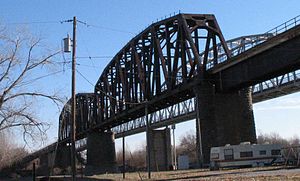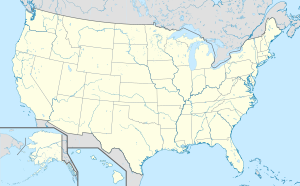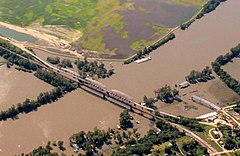Rulo Rail Bridge
Coordinates: 40 ° 3 ′ 16 ″ N , 95 ° 25 ′ 15 ″ W.
| Rulo Rail Bridge | ||
|---|---|---|
| In the foreground the 2006 railway bridge, behind it the old road bridge (1939–2013), view to the southeast | ||
| use | Railway bridge | |
| Crossing of | Missouri River | |
| place |
Rulo, Nebraska and Holt Counties, Missouri |
|
| Entertained by | BNSF Railway | |
| construction | Truss bridge | |
| overall length | 607 m | |
| Longest span | 116 m | |
| opening | 1887, 1977 | |
| location | ||
|
|
||
The Rulo Rail Bridge is a single-track railroad bridge across the Missouri between the small community of Rulo , Nebraska and Holt County , Missouri . It goes back to a truss bridge from 1887 that was built by George S. Morison for the Chicago, Burlington and Quincy Railroad (CB&Q). The CB&Q was incorporated into Burlington Northern (BN) in 1970 , which built a new bridge in 1977 using the old masonry bridge piers. Only two of the originally three 116 meter long lattice girders were used for the execution and the rest of the structure was realized with solid wall girders on partly new concrete pillars. The BN merged in 1995 to form the BNSF Railway , which now operates the bridge as part of its St. Joseph subdivision between Lincoln and Kansas City .
First bridge 1887
Bridges the Morison 1880-1888 built |
The Missouri, like the Mississippi, represented a natural barrier for the western expansion of the US railroad network. The first railroad bridge over the Missouri was built with the Hannibal Bridge in Kansas City (Missouri) until 1869 on the operation of the then President of the CB&Q James Frederick Joy , who also the eponymous Hannibal and St. Joseph Railroad (H & StJ) controlled. The young George S. Morison was involved in the construction . Under Octave Chanute he made his first experience as a civil engineer and was later to build ten more bridges over the Missouri. Between 1880 and 1888 he built six bridges on the Nebraska border , including three for the CB&Q. For the then president of the CB&Q Charles Elliott Perkins , Morison built the Plattsmouth Railroad Bridge until 1880, and in 1883 Perkins wanted to connect the recently incorporated H & StJ to the network reaching as far as Denver in Colorado through a bridge at Rulo . After initial investigations in September 1883, the construction was delayed due to the high estimated costs and a controversy about the execution of the bridge until the end of 1885. Morison was finally able to come up with a high bridge without moving parts, which would have been necessary for shipping with a low superstructure , push through.
By the autumn of 1887 a more than 600 meter long truss bridge made of steel and wrought iron was built . Morison chose three 116-meter-long Whipple trusses with a track below as the central elements (English whipple truss , after its inventor Squire Whipple , 1804–1888), which rested on four stone pillars erected using caissons , followed by three shorter trusses each with track above Side, which were supported by two metal pillars between the river pillars and the abutments and each formed a 130-meter-long trestle bridge . The river pillars, made of granite stone, tower over 18 meters above low water and enable the successor structure to have a clearance height of over ten meters in extreme floods.
In the 1930s, the Rulo Bridge was built in the immediate vicinity of the railway bridge, a truss bridge for the US 159, which was executed in a similar design and subdivision of the central girders and whose piers were erected only about 15 meters downstream in the river bed.
Second bridge 1977
As part of the consolidation of rail freight in the USA, the CB&Q merged in 1970 with the Great Northern Railway , the Northern Pacific Railway and the Spokane, Portland and Seattle Railway to form Burlington Northern Inc. (BN), which was renamed Burlington Northern Railroad in 1981 ; passenger traffic was largely taken over by Amtrak around the same time . The BN invested in the expansion of its routes in the 1970s, among other things due to the increasing coal transport from the Powder River Basin in Wyoming and Montana . In 1977 the 90-year-old bridge in Rulo was given a new superstructure, for which only two of the originally three 116-meter-long lattice girders were used. The rest of the bridge was replaced by solid wall girders , for which additional new concrete pillars were built, but the old stone pillars were reused. The BN finally merged in 1995 to form the BNSF Railway , which still operates the bridge as an important part of its St. Joseph subdivision between Lincoln and Kansas City . In 2013, an average of 43 trains a day crossed the bridge, most of which were coal block trains .
The neighboring road bridge was replaced by a new four-lane building around 200 meters further downstream and demolished by 2013.
Web links
- Rulo Bridge, Spanning Missouri River, Rulo, Richardson County, NE. Historic American Engineering Record, HAER NE-4.
literature
- Clayton B. Fraser: Nebraska City Bridge. Historic American Engineering Record, HAER No. NE-2, Denver, Colorado 1986, pp. 139-160.
- George S. Morison: The Rulo Bridge: A Report to Charles E. Perkins, President of the Chicago, Burlington, and Quincy Railroad. Chicago 1890.
Individual evidence
- ^ A b Clayton B. Fraser: Nebraska City Bridge. Historic American Engineering Record, HAER No. NE-2, Denver, Colorado 1986, pp. 139-160.
- ↑ Demian Hess: Rulo Bridge. National Register of Historic Places Inventory Nomination Form, United States Department of the Interior, National Park Service, 1991.
- ^ Transportation: Current Literature. US Department of Transportation, Library Services Division, 1977, p. 4 ( limited preview in Google Book Search); Michael Donahue (Burlington Northern Railroad): Corporate Planning: Transportation Demand, Rail Freight Operation Considerations. In: Forecasts of Freight System Demand and Related Research Needs. Workshop Proceedings, 12. – 13. June 1978, National Academy of Sciences Washington, Part 3, pp. 109-119, here pp. 111 f. ( limited preview in Google Book search).
- ↑ a b Algis J. Laukaitis: Tearing down the old Rulo Bridge is dangerous dance. ( April 5, 2014 memento on the Internet Archive ) Lincoln Journal Star, November 30, 2013.




